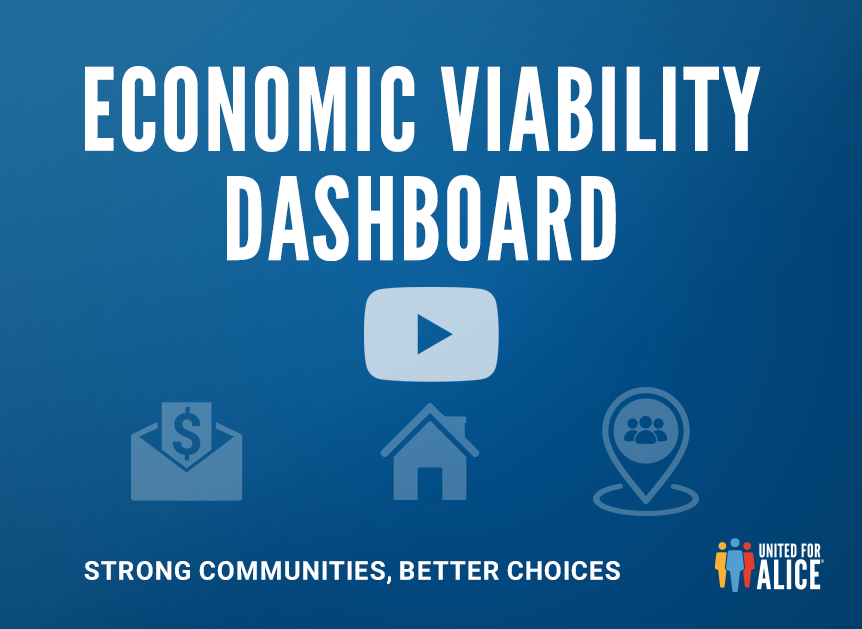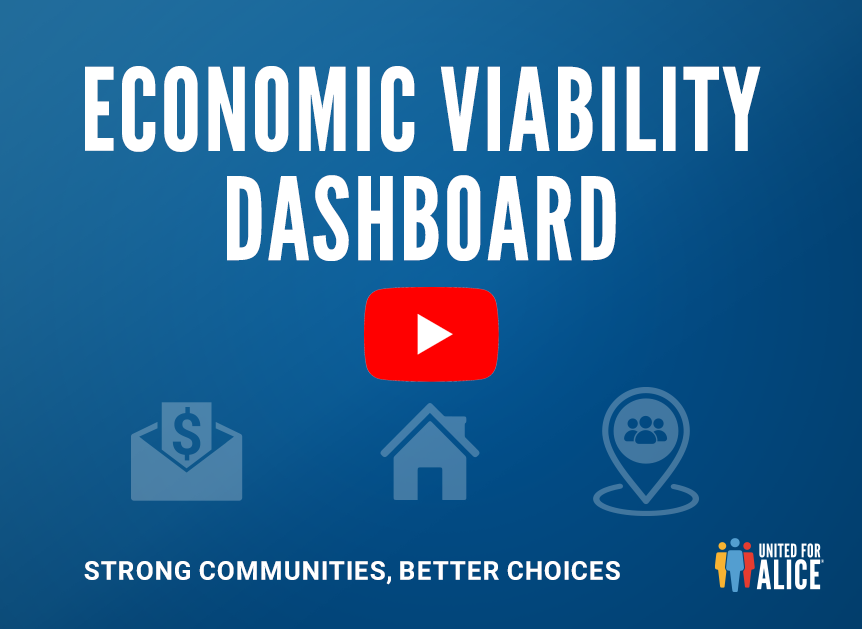Research Center • ALICE ECONOMIC VIABILITY DASHBOARD
Measuring Economic Well-Being for ALICE
The ALICE Economic Viability Dashboard reveals the economic and community conditions of people who are struggling financially — those below the ALICE Threshold. This includes people in households with income below the Federal Poverty Level (FPL) and those who are ALICE (Asset Limited, Income Constrained, Employed), with income above the FPL but below the cost of basics.
By studying ALICE households as well as those in poverty, United For ALICE research shows the true extent of financial hardship across the country. The ALICE Economic Viability Dashboard builds on this research, exploring why so many households are struggling, with new data on ALICE work, housing, and community resources.
Hover/click on the elements below to learn more:
Work

Explore the percentage of full-time workers below the ALICE Threshold who earn enough to afford the Household Survival Budget (1 adult and 1 school-age child) and gain deeper understanding of ALICE workers in the state and local labor force. Variables include:
- Workers below the ALICE Threshold and their wages, demographics, common industries, educational attainment, and commute time
- People below the ALICE Threshold who are out of the labor force and their characteristics
Housing

See the percentage of households below the ALICE Threshold in affordable housing, along with other key variables, including the percentage of households below the Threshold who…
- Own their home
- Are rent or owner cost burdened
- Are renting yet paying more than median owner costs
Community

Better understand the supports that communities provide to help ALICE meet basic needs, including…
- Preschool enrollment
- High-speed internet
- Commute time
- Health insurance
- Grocery store access
Gaps

Use the Gap Map and index scores to see and compare community performance on each domain (Work, Housing, Community).
What can users do with this dashboard?
- Explore data on work, housing, and community resources for households below the ALICE Threshold by location and race/ethnicity
- Compare any two locations on key ALICE work, housing, and community conditions
- Create action plans to remove barriers, fill gaps, and make structural changes needed to improve conditions for workers and households in your state or local community
What is unique about this dashboard?
- It focuses specifically on workers and households that are unable to afford the basics based on income and local cost of living
- It combines economic and equity perspectives
- It offers actionable data and best practices to address gaps across states and local communities
Who is this dashboard for?
- Community planners, engineers, builders, real estate developers, zoning experts, and housing advocates
- Local, state, and federal policymakers
- Chambers of commerce and economic development agencies
- United Ways and other key community nonprofit organizations
- Advocates working for equity in education, food, transportation, health care, and technology
ALICE Economic Viability Dashboard Action Planner
Now that you’ve learned more about ALICE in your community, it’s time to act! Use the tool below to better understand the needs of ALICE households in your selected community in order to set goals and plan for action.
Use the buttons and drop-down menus below to select a domain (Work, Housing, Community) and a geography (state, or one or more PUMAs). For counties with multiple PUMAs, select all related PUMAs to see county-level data.
What is a PUMA?
- PUMAs are Census statistical geographies containing no fewer than 100,000 people that allow for meaningful analysis and comparison. In areas where the population is less dense (more rural), PUMAs tend to cover one or more counties. In more densely populated areas (more urban), counties and cities are generally split into multiple PUMAs.
Work
Promising Practices: Work
Once you’ve identified key areas for action in your state or community, use the promising practices below to help inform your action-planning process. Click a promising practice below to learn more.
Note: The promising practices linked below have been suggested by our Research Advisory Committee members and ALICE stakeholders. United For ALICE does not endorse any specific strategy or organization linked below; local stakeholders are best positioned to select and implement strategies that fit their community’s strengths and needs.
Description: Benefit cliffs occur when individuals face a significant reduction or complete loss of public assistance benefits if their income exceeds certain thresholds. This sudden loss of support can impede financial stability and the ability to earn more, as even with a raise, individuals can end up worse off financially due to the loss of benefits.
Description: An apprenticeship involves students working with an experienced employee of the chosen organization. The student is periodically evaluated for progress as per the skills and knowledge acquired, and generally paid for their time. At the end of the apprenticeship, the student receives a certificate of service. The student learns in a realistic environment and gets the opportunity to apply knowledge in real-world scenarios.
Learn More: https://www.apprenticeship.gov/career-seekers
Description: Career clusters are groups of related occupations and industries that share similar skills, interests, and educational pathways. These clusters provide a roadmap for students and job seekers to identify, explore, and plan their career paths and acquire the educational/training requirements needed to pursue them.
Learn More: https://careertech.org/career-clusters
Description: In cooperative education, the work experience is planned in conjunction with technical classroom instruction. This method is used by universities that do not have access to state-of-the-art equipment required to transact the technical course practically. School-based enterprise: A school-based enterprise is a simulated or actual business run by the school. It offers students a learning experience by letting them manage the various aspects of a business.
Learn More: https://www.naceweb.org/career-development/internships/understanding-cooperative-education/
Description: Beyond wages, there is so much more an employer can offer an employee that can improve their overall financial wellness. By covering some or all the cost of an employer-sponsored health plan, employers can help employees maintain their health. Prioritizing benefits including paid time off, consistent scheduling, and more robust, equitable 401(k) plans help employees plan for family expenses and future needs. Explore the case studies below to see how area companies are tackling these issues to address the needs of their workforce.
Learn More: https://united4alice.org/EVD-BenefitsComp
Description: Learning new skills takes time and resources, both of which are scarce for individuals that are already juggling the demands of family and work, sometimes even at multiple jobs. By offering training and growth opportunities, employers foster a culture where employees feel valued and they are often repaid in loyalty and dedication.
Learn More: https://united4alice.org/EVD-ProfessionalDevelopment
Description: Employers can help their employees meet basic needs including creatively addressing transportation challenges (e.g., via rideshares and car repair loans); connecting employees with support services; and supporting caregiving employees.
Learn More: https://United4ALICE.org/EVD-WorkSupport
Description: Child care issues are one of the major reasons parents, particularly mothers, leave their jobs. There are several ways employers can help to support child care for their workers: Understand parents' child care needs and the pain points; provide partial or full tuition for subsidies for center or home-based care, flexible spending accounts for dependent care, or finance models; provide on-site care or contract with child care program to provide access on-site; establish flexible arrangements and hours; offer backup child care provider; educate your workforce about government programs and tax credits (CDTC); advocate for policies that support a better child care system, i.e. universal preschool.
Description: Having a reliable schedule is something that many of us take for granted, but for many hourly workers the lack of a dependable schedule wreaks havoc on a family’s ability to plan and budget for expenses. Small changes making a worker’s schedule more predictable and hours more consistent go a long way for their overall family and financial stability.
Learn More: https://united4alice.org/EVD-ReliableScheduling
Description: Employment transportation strategies include promoting existing transportation services, offering Commuter Tax Benefits, connecting businnesses with local transportation planning committees/processes, adjusting shift schedules to better match public transportation times, surveying employees to assess transportation needs, and providing direct transportation services (like shuttle service).
Learn More: https://nationalcenterformobilitymanagement.org/by-topic/by-topic-employment-transportation-strategies/
Description: This strategy aims to support local entrepreneurship in communities that have experienced systemic disinvestment resulting from longstanding racist policies and practices. Key activities include business training, high-risk lending, technical assistance, and real estate opportunities.
Learn More: https://www.bfwalliance.org/
Description: Gain deeper insight into local businesses and industries by sector. Address employment and industry gaps in local communities to better match where workers live to where they work.
Learn More: https://qwiexplorer.ces.census.gov/#x=0&g=0
Description: Promote emerging jobs that challenge sectoral stereotypes and equip ALICE to do high-tech, high-touch work.
Description: Adult vocational training includes programs/courses designed to provide specialized skills and knowledge to adults, in order to prepare them for specific careers in fields like health care, technology, trades, and more. Without formal education, median income for ALICE families is limited. As an affordable alternative, these programs enhance employability and earning potential.
Learn More: https://www.oecd.org/education/skills-beyond-school/vet.htm
Learn More
See what United for ALICE partners are doing to make a difference for ALICE in their communities in our ALICE in Action Database
Technical Details
- ALICE Economic Viability Dashboard Variables: To see a list of all variables and their sources and definitions, click on the “Framework & Variables” tab.
- Below ALICE Threshold: Below ALICE Threshold variables are based on the U.S. Census Bureau Public Use Microdata Sample, which includes individual-level data. Individuals are mapped to households in the dataset, and this household-level data is used to determine ALICE Threshold status. If combined household income (for all members of the household) is less than the ALICE Threshold for their household size, composition, and location, that household and all members are below the ALICE Threshold. People and households below the ALICE Threshold include those that are below the Federal Poverty Level and those that are ALICE. Some variables in the dashboard are individual-level (including all work variables), and some are household-level (including all housing variables). Variable labels and descriptions include level of analysis, for ease of reference.
- Rounding: Percentages are rounded to whole numbers for ease of reading, which may result in percentages totaling 99% or 101%.
- Missing data: Any group with fewer than 100 individuals or households (depending on the variable) is suppressed (not shown) to maintain accuracy and confidentiality. For missing wages in the Work domain, there was insufficient source data to calculate a full-time wage.
- Race/ethnicity: All racial categories except Two or More Races are for one race alone, non-Hispanic. The Hispanic group may include individuals/households of any race.
- Index scores: Variables in the dashboard are composed of different kinds of measures. The first step is therefore to create a common scale across rates, percentages, and other scores by measuring from the average. Raw indicator scores are converted to “z-scores”, which measure how far any value falls from the mean of the set, measured in standard deviations. The formula for normalizing indicator scores is: z = (x – μ) / σ where x is the indicator’s value, μ is the national median, σ is the standard deviation for that indicator, and z is the resulting z-score. Scores are translated to a scale of 0 to 100, with 50 in the middle. Index scores have been created for the top Work variable (Full-Time Workers Earning Enough for Household Survival Budget (1 Adult, 1 School-age Child), the top Housing variable (the percentage of renter households below the ALICE Threshold paying less than 30% of income on rent), and all variables included in the Community composite score (see below).
- Community composite score: An average of the index scores created for each variable in this section, including the percentage of children age 3–4 in households below the ALICE Threshold who are enrolled in school; the percentage of households below the ALICE Threshold with high-speed internet access at home; the percentage of workers below the ALICE Threshold commuting 30 minutes or less to work; the percentage of adults below the ALICE Threshold (age 16–64) with health insurance; and the rate of grocery stores per 100,000 households below the ALICE Threshold.
- Geographic crosswalk: Some variables are only available at the county level. For these datasets, county totals are crosswalked and weighted into corresponding PUMAs using 2020 U.S. Census Bureau relationship files and number of households, first by crosswalking county totals to census tracts, then census tracts to PUMAs, with weighting based on the distribution of total households across each county.






